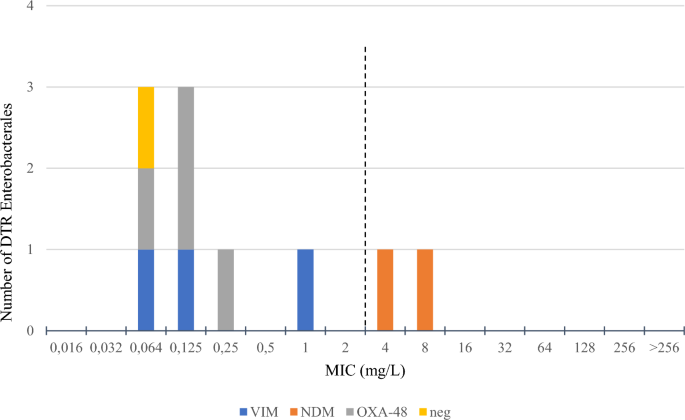Bacterial resistance surveillance is crucial for effective antimicrobial stewardship (AMS). In this study, researchers carried out a retrospective study analyzing the susceptibility patterns of bacterial isolates, particularly focusing on difficult-to-treat resistance (DTR) phenotypes among Gram-negative pathogens.
Study Design and Cohort:
- The study analyzed 90 unique isolates of critical priority pathogens obtained from ICU patients over the period of 2017–2021.
- Half of the isolates fulfilled DTR criteria, indicating significant resistance challenges.
- Susceptibility testing was conducted for selected antimicrobial agents, including colistin, cefiderocol, imipenem/cilastatin/relebactam, ceftazidime/avibactam, fosfomycin, and aztreonam/avibactam.
Key Findings:
- Prevalence and Distribution of DTR Phenotypes:
- DTR Gram-negative pathogens were prevalent, with higher rates observed in severe infection samples compared to bloodstream infections.
- 𝘈. 𝘣𝘢𝘶𝘮𝘢𝘯𝘯𝘪𝘪, 𝘗. 𝘢𝘦𝘳𝘶𝘨𝘪𝘯𝘰𝘴𝘢, 𝘢𝘯𝘥 𝘌𝘯𝘵𝘦𝘳𝘰𝘣𝘢𝘤𝘵𝘦𝘳𝘢𝘭𝘦𝘴 comprised the majority of DTR strains.
- Resistance patterns varied across pathogens, with notable differences in susceptibility to specific antimicrobial agents.
- Effectiveness and Limitations of Current Antibiotics:
- Colistin, a historically important “last resort” antibiotic, showed limited efficacy and challenges in susceptibility testing.
- Fosfomycin exhibited potential against resistant pathogens but faced difficulties in susceptibility determination.
- New antibiotics like ceftazidime/avibactam, ceftolozane/tazobactam, imipenem/cilastatin/relebactam, cefiderocol showed promise against DTR isolates.
- Ceftazidime/avibactam and ceftolozane/tazobactam were effective against carbapenemase-producing 𝘗. 𝘢𝘦𝘳𝘶𝘨𝘪𝘯𝘰𝘴𝘢, 𝘢𝘯𝘥 𝘌𝘯𝘵𝘦𝘳𝘰𝘣𝘢𝘤𝘵𝘦𝘳𝘢𝘭𝘦𝘴 strains.
- Cefiderocol demonstrated high activity against DTR isolates but was limited by availability.
- Challenges in Antibiotic Susceptibility Testing:
- Susceptibility testing methods for colistin and fosfomycin faced limitations, impacting accurate interpretation.
- Interpretation criteria were lacking for newer antibiotics like aztreonam/avibactam, hindering clinical application.
- Implications for Antimicrobial Stewardship:
- Proper classification of resistance phenotypes, particularly DTR, is essential for guiding antibiotic therapy.
- Phenotypic susceptibility testing remains crucial despite advancements in genotypic methods.
- Laboratories should prioritize minimizing time-to-result for timely patient management.
The study underscores the importance of robust bacterial resistance surveillance and antimicrobial stewardship efforts. Despite challenges in susceptibility testing and limitations of current antibiotics, newer agents show promise against DTR pathogens. However, further research and clinical validation are needed to optimize their use in combating antimicrobial resistance.
This report highlights the dynamic landscape of antibiotic resistance and emphasizes the ongoing need for vigilance and innovation in antimicrobial stewardship practices to address evolving resistance challenges effectively.
Link to the article : https://tinyurl.com/8bj4p52j
